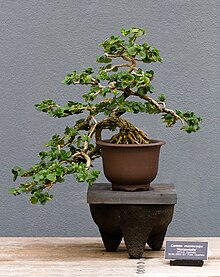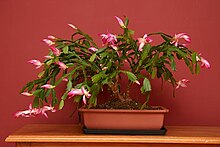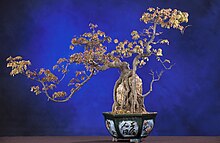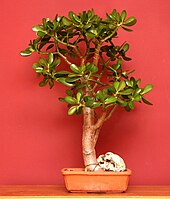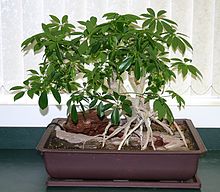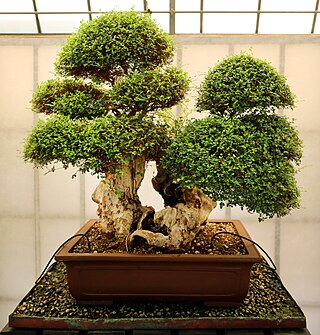
Bonsai is the Japanese and East Asian art of growing and training miniature trees in containers, developed from the traditional Chinese art form of penjing . Penjing and bonsai differ in that the former attempts to display "wilder," more naturalistic scenes, often representing landscapes, including elements such as water, rocks, or figurines; on the other hand, bonsai typically focuses on a single tree or a group of trees of the same species, with a higher level of aesthetic refinement. Similar versions of the art exist in other cultures, including the miniature living landscapes of Vietnamese Hòn non bộ. During the Tang dynasty, when penjing was at its height, the art was first introduced in China.

A tropical garden is a type of garden that features tropical plants and requires heavy rainfall or a decent irrigation or sprinkler system for watering. These gardens typically need fertilizer and heavy mulching.

Ficus benjamina, commonly known as weeping fig, benjamin fig or ficus tree, and often sold in stores as just ficus, is a species of flowering plant in the family Moraceae, native to Asia and Australia. It is the official tree of Bangkok. The species is also naturalized in the West Indies and in the states of Florida and Arizona in the United States. In its native range, its small fruit are favored by some birds.

Aerial roots are roots above the ground. They are almost always adventitious. They are found in diverse plant species, including epiphytes such as orchids (Orchidaceae), tropical coastal swamp trees such as mangroves, banyan figs, the warm-temperate rainforest rata, and pohutukawa trees of New Zealand. Vines such as common ivy and poison ivy also have aerial roots.

Ficus microcarpa, also known as Chinese banyan, Malayan banyan, Indian laurel, curtain fig, or gajumaru (ガジュマル), is a tree in the fig family Moraceae. It is native in a range from China through tropical Asia and the Caroline Islands to Australia. It is widely planted as a shade tree and frequently misidentified as F. retusa or as F. nitida.
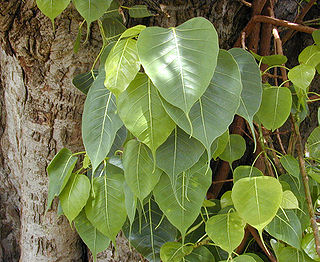
Ficus religiosa or sacred fig is a species of fig native to the Indian subcontinent and Indochina that belongs to Moraceae, the fig or mulberry family. It is also known as the bodhi tree, pimple tree, peepul tree, peepal tree, pipala tree, ashvattha tree, or Asathu (ඇසතු) in Sinhala. The sacred fig is considered to have a religious significance in three major religions that originated on the Indian subcontinent, Hinduism, Buddhism and Jainism. Hindu and Jain ascetics consider the species to be sacred and often meditate under it. A tree of these species under which Gautama Buddha is believed to have attained enlightenment. The sacred fig is the state tree of the Indian states of Odisha, Bihar and Haryana.

Ficus elastica, the rubber fig, rubber bush, rubber tree, rubber plant, or Indian rubber bush, Indian rubber tree, is a species of flowering plant in the family Moraceae, native to eastern parts of South and Southeast Asia. It has become naturalized in Sri Lanka, the West Indies, and the US state of Florida. Despite its common names, it is not used in the commercial production of natural rubber.

Heptapleurum arboricola is a flowering plant in the family Araliaceae, native to Taiwan and Hainan Province, China. Its common name is dwarf umbrella tree, as it resembles a smaller version of the umbrella tree, Heptapleurum actinophyllum.
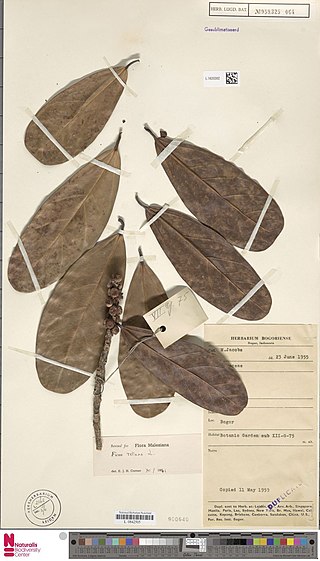
Ficus retusa is a species of evergreen woody plant in the fig genus, native to the Malay Archipelago and Malesia floristic region. The species name has been widely mis-applied to Ficus microcarpa.

Ficus lyrata, commonly known as the fiddle-leaf fig, is a species of flowering plant in the mulberry and fig family Moraceae. It is native to western Africa, from Cameroon west to Sierra Leone, where it grows in lowland tropical rainforest. It can grow up to 12–15 m (39–49 ft) tall.

Carmona is a genus of flowering plants in the borage family, Boraginaceae. Members of the genus are commonly known as scorpionbush.

Pachira aquatica is a tropical wetland tree in the mallow family Malvaceae, native to Central and South America where it grows in swamps. It is known by its common names Malabar chestnut, French peanut, Guiana chestnut, Provision tree, Saba nut, Monguba (Brazil), Pumpo (Guatemala) and is commercially sold under the names Money tree and Money plant. This tree is sometimes sold with a braided trunk and is commonly grown as a houseplant, although more commonly what is sold as a "Pachira aquatica" houseplant is in fact a similar species, P. glabra.

Dypsis lutescens, also known as golden cane palm, areca palm, yellow palm, butterfly palm, or bamboo palm, is a species of flowering plant in the family Arecaceae, native to Madagascar and naturalized in the Andaman Islands,Thailand, Vietnam,Réunion, El Salvador, Cuba, Puerto Rico, the Canary Islands, southern Florida, Haiti, the Dominican Republic, Jamaica, the Leeward Islands and the Leeward Antilles. Its native names are rehazo and lafahazo.

Saikei (栽景) literally translates as "planted landscape". Saikei is a descendant of the Japanese arts of bonsai, bonseki, and bonkei, and is related less directly to similar miniature-landscape arts like the Chinese penjing and the Vietnamese hòn non bộ. It is the art of creating tray landscapes that combine miniature living trees with soil, rocks, water, and related vegetation in a single tray or similar container. A saikei landscape will remind the viewer of a natural location through its overall topography, choice of ground materials, and the species used in its plantings.
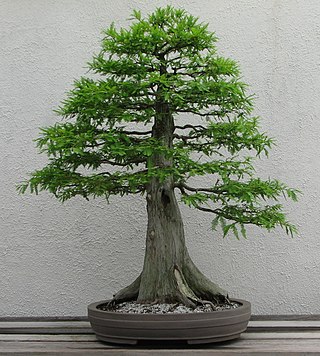
Bonsai aesthetics are the aesthetic goals and characteristics of the Japanese tradition of the art of bonsai, the growing of a miniature tree in a container. Many Japanese cultural characteristics, particularly the influence of Zen Buddhism and the expression wabi-sabi inform the bonsai tradition in that culture. A lengthy catalog of conventional tree shapes and styles also helps provide cohesion to the Japanese styling tradition. A number of other cultures around the world have adopted the Japanese approach to bonsai, and while some variations have begun to appear, most hew closely to the rules and design philosophies of the Japanese tradition.

Chamaedorea elegans, the neanthe bella palm or parlour palm, is a species of small palm tree native to the rainforests in Southern Mexico and Guatemala. The parlor palm is one of the most extensively sold houseplant palms in the world. It is one of several species with leaves that are harvested as xate.
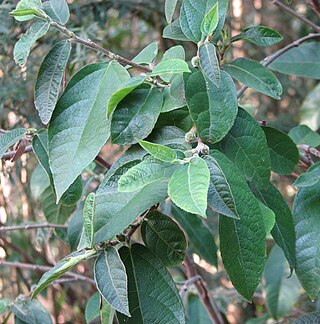
Ficus coronata, commonly known as the sandpaper fig or creek sandpaper fig, is a species of fig tree, native to Australia. It is found along the east coast from Mackay in Central Queensland, through New South Wales and just into Victoria near Mallacoota. It grows along river banks and gullies in rainforest and open forest. Its common name is derived from its rough sandpapery leaves, which it shares with the other sandpaper figs.

Ficus obliqua, commonly known as the small-leaved fig, is a tree in the family Moraceae, native to eastern Australia, New Guinea, eastern Indonesia to Sulawesi and islands in the southwestern Pacific Ocean. Previously known for many years as Ficus eugenioides, it is a banyan of the genus Ficus, which contains around 750 species worldwide in warm climates, including the edible fig. Beginning life as a seedling, which grows on other plants (epiphyte) or on rocks (lithophyte), F. obliqua can grow to 60 m (200 ft) high and nearly as wide with a pale grey buttressed trunk, and glossy green leaves.

Bonsai cultivation and care involves the long-term cultivation of small trees in containers, called bonsai in the Japanese tradition of this art form. Similar practices exist in other Japanese art forms and in other cultures, including saikei (Japanese), penjing (Chinese), and hòn non bộ (Vietnamese). Trees are difficult to cultivate in containers, which restrict root growth, nutrition uptake, and resources for transpiration. In addition to the root constraints of containers, bonsai trunks, branches, and foliage are extensively shaped and manipulated to meet aesthetic goals. Specialized tools and techniques are used to protect the health and vigor of the subject tree. Over time, the artistic manipulation of small trees in containers has led to a number of cultivation and care approaches that successfully meet the practical and the artistic requirements of bonsai and similar traditions.

Ficus amplissima, also known as the Indian Bat tree, Indian Bat fig, Pimpri, Pipri (Piparee), Pipali or Bilibasari mara is a tree species of flowering plants that belongs to Moraceae, the fig or mulberry family. It is native to Central and southern Peninsular India, Sri Lanka and Maldives, having a significant distribution throughout Western Ghats of India. It is most commonly planted to provide shade in coffee plantations due to its dense and wide foliage. The ripened figs attract many birds, especially during the spring.
